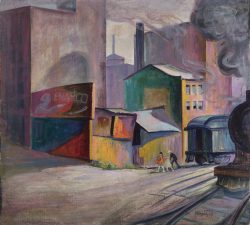P. R. McIntosh 1897–1985
Born in rural New Salisbury, Indiana, Pleasant Ray McIntosh took up art as a youth. He studied at Bradley Polytechnic Institute (now Bradley University) in Peoria, Illinois, and served in the U.S. Army in Europe during World War I.i McIntosh then enrolled at the Art Institute of Chicago, where he earned a Three-Year Diploma in 1922 (his BAE and MFA were awarded retroactively, in 1945).ii With a family to support, McIntosh made a career in art teaching and administration. He taught at Ohio State University from 1923 to 1926 and then moved to Peoria as director of the Peoria Art Institute, subsequently heading the art department at Bradley. McIntosh spent a summer as a fellow at the Tiffany Foundation on Long Island, New York, a retreat for artists and craftspeople founded by Louis Comfort Tiffany.
In 1945 McIntosh was one of twenty-four American artists and teachers selected to serve as instructors in the U.S. Army’s overseas university campus in Biarritz, France, for demobilized American servicemen and -women.iii When the campus was closed in 1946, the artist visited Paris and had a solo exhibition there at the Galerie Jean Dufresne. In 1949 he was appointed an associate professor of art at the University of Florida, where he remained until his retirement in 1968. In his last years, McIntosh traveled widely for landscape subjects and made a second home on the Caribbean island of Dominica. In the course of his career the artist showed his work in numerous solo exhibitions in hotels, clubs, and similar venues, maintaining a largely local reputation.
McIntosh’s paintings varied widely, ranging from somberly colored scenes of life in the Depression era to vivid rural landscapes; he also painted portraits and figural works, for which his wife and four children frequently modeled. McIntosh’s early works in oil and watercolor were representational but modern in feeling and color, as demonstrated by his 1927 Train Yard. During World War II, he painted a series of murals on the theme of Four Freedoms (Peoria Central High School) for a War Bonds drive. By that date, influenced by Surrealism, McIntosh was described as a subjective or “impressionistic” painter whose imagery reflected a personal, emotional reaction to his subject.iv In the following decades the artist created non-representational compositions, using vivid color and a graphic approach that reflected the aesthetics of postwar modernist design.
Wendy Greenhouse, PhD
i U.S. Army Transport Service Passenger Lists, 1910–1939, at ancestry.com (accessed Apr. 13, 2018).
ii Information courtesy of the Office of Registration and Records, School of the Art Institute of Chicago, via email, Apr. 13, 2018.
iii “Bradley Professor to Teach in Europe,” Decatur Daily Review, July 3, 1945.
iv “Debate on Painting Styles,” Decatur Daily Review, Dec. 2, 1941; “Artists Depict Two ‘Schools,’” Decatur Daily Review, Dec. 4, 1941. See also “Context Shows Art Growth in Central Illinois,” Decatur Daily Review, Feb. 21, 1943.
